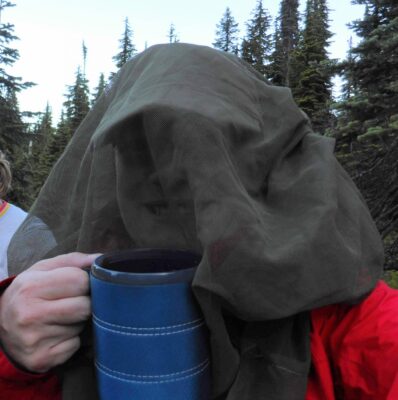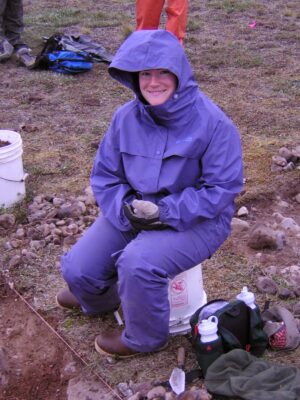How to Deal with Mosquitoes in Alaska (and elsewhere)
Last Updated on February 24, 2024
One question visitors commonly have about Alaska travel is “when can I go without bugs”?? And, I get it. Dealing with bad bugs and not be prepared is the WORST. Since you can’t control the bugs and you can’t even fully predict when they will be bad, I recommend trying not to worry about it when you’re planning your trip and instead focus on how to deal with mosquitoes in Alaska. Good news!
You can trust me on this topic, since I lived in Alaska for 7 years and my husband spent several seasons as a field archaeologist in epically buggy Gates of the Arctic National Park, which has the worst bugs I’ve ever seen. In our family we take mosquito protection seriously! Both of us have also led tours in buggy environments so we know all about how to deal with mosquitoes while exploring, hiking and camping. This is a round up of our best advice!
How to avoid mosquitoes in Alaska in the first place
I already mentioned that this isn’t something you can control, but you can control it a little. If you definitely for sure want to avoid all mosquitoes on your trip to Alaska, then visit in the winter! In May you can often beat the bugs (though not always) and September rarely has many bugs, if any. Learn more about the ups and downs of different months to visit Alaska here.
If you are visiting in late May, June, July and August (especially June and July) you’ll want to be prepared for mosquitoes.
Things that make mosquitoes worse
Regardless of the time of year, you can expect worse bugs when:
- You’re near any type of water – river, lake, etc
- The ground is wet
- The further north you are (they are way worse in the Arctic than they are in Juneau, for example)
- You’re changing a flat tire or setting up a tent (just kidding, I think it only feels that way)
Even without these factors, you might still be dealing with mosquitoes, but these tend to be exceptionally bad situations.
Things that make mosquitoes better
- Dry locations with dry ground
- Cold (freezing at night definitely ends them)
- Wind
- Loose fitting clothing or rain gear
- A headnet – it is a complete game changer for your sanity to have this! And it weighs nothing as is cheap.
One thing that doesn’t seem to matter much is the time of day. I haven’t found that the time of day makes any difference for mosquitoes in Alaska. This is not the case in other places, when they tend to be worse and dusk and dawn.
Real talk about Bug Spray
When determining how to deal with mosquitoes, an obvious solution is to spray bug spray all over your body. I’m sure there will be plenty of people who disagree with me here, but you have to use deet (yes, the evil chemical stuff). I just haven’t found a more natural alternative that works when the bugs are really bad. It needs to be at least 30%, which is what I carry. It is a harsh chemical so it’s important to wash it off (in the backcountry I use wet wipes). Also, I never put it on my face or hands (sometimes on the back of my hands if bugs are really bad, but not on palms). The truth about bug spray is that it isn’t fool proof and it also doesn’t stop bugs from swarming around you. I use the bug spray mostly around places that aren’t as well covered by other clothes or they tend to get through (back of shoulders, neck, ankles).
What you are wearing is way more important than bug spray when mosquitoes are really swarming.
What to wear to deal with mosquitoes

Choosing what you wear carefully is the most important factor in how to deal with mosquitoes and not be driven completely out of your mind. This is so much more important than bug spray! Here’s what I wear to deal with mosquitoes:
- A hat with a brim (so that you can easily put a headnet over it)
- A long sleeved shirt: You can also get it treated with insecticide, which is more expensive but probably a good idea (I use this non-treated shirt because it’s the one I have). You can actually use any loose fitting button up shirt. I like white because it helps keep you cool (also doubles as sun protection). It does get dirty but I only wear it outside so who cares! It’s important for the shirt to not be too tight fitting, since unfortunately bugs can bite through tight fitting clothing! I usually wear a tight fitting tank top under it.
- Long pants: Loose fitting and in a light color. Leggings are awesome for warmth and comfort, but terrible for bugs, which will bite you right through them. If you put your hiking pants or rain pants on over them, then you’ll be set.
- Bring your rain gear, and put it on if bugs are bad. I know this sounds bizarre, especially when it’s hot in the summer. Truthfully, I can hardly hike in rain gear when it’s cold and rainy, and definitely not in summer! However, rain gear can make a world of difference if you’re sitting around in bad bugs, especially if you’re camping and especially if you’re backpacking. If you’re sitting around, it’s not so bad to have an extra layer on and rain gear is absolutely the MOST effective way to prevent getting bitten. So, it’s a trade off! You’ll look ridiculous, but you’ll be happy!

- Carry a headnet it your pack. It might look ridiculous and seem silly, but let me tell you, it is an absolute lifesaver if the bugs get really bad. On top of that, it weighs almost nothing, fits in the bottom of your pack and costs less than $10. If you have rain gear on and a hat and headnet, there is no way you’re going to get bitten.
- If you’re camping with bad mosquitoes, use earplugs to cut back on the buzzing noise, which can drive you crazy at night! This is really only an issue if you’re sleeping in a tent with bad mosquitoes.
Have a bug free place to retreat to
It makes a huge difference to have a bug free place to retreat too! If you’re camping, you can use your tent as a screen porch (see below) or get another type of screen porch to put around a picnic table. Make sure it doesn’t have any holes and that you have something to repair any holes with (like duct tape).
If you’re not camping, make sure to leave vehicle windows and doors closed when you’re not getting in and out of it. And wherever you’re staying, make sure to keep windows and doors closed (or open with tight screens free of holes). Make sure everyone in your group is vigilant about this. Block any holes in screens or screen doors. Inspect screens when you check in or pick up your RV and make sure they are solid.
Use your tent as a screen porch if camping

The last tip I have is if you’re camping, use your tent as a screen porch! Just remove the rain fly (this makes it less hot) and you’ve got a pleasant way to relax outdoors without worrying about bug bites. Make sure that you keep all the zippers tightly shut when you go in and out! The view from inside the screen is nearly as good as the one outside, with way less bugs swarming and less bites to deal with!



